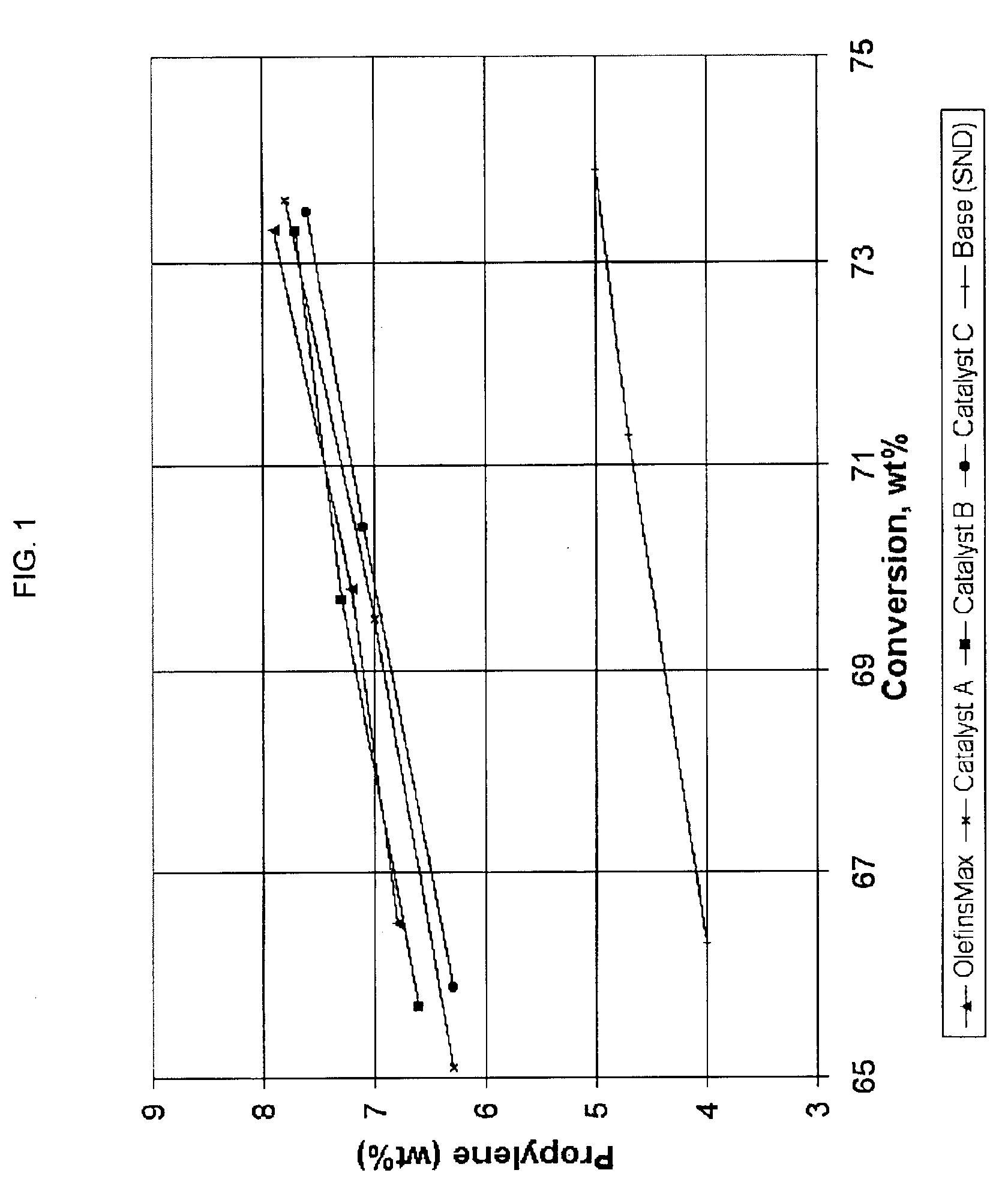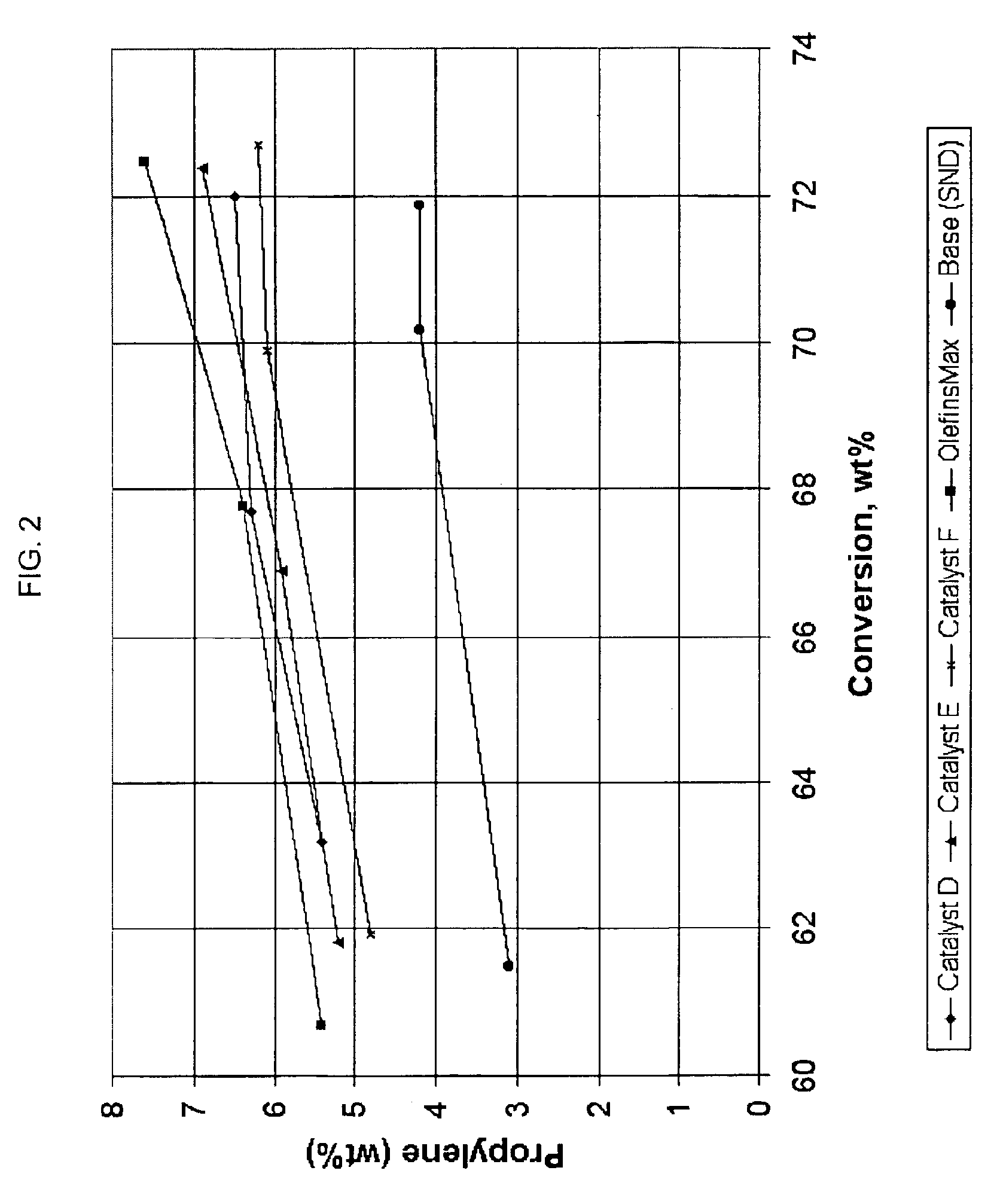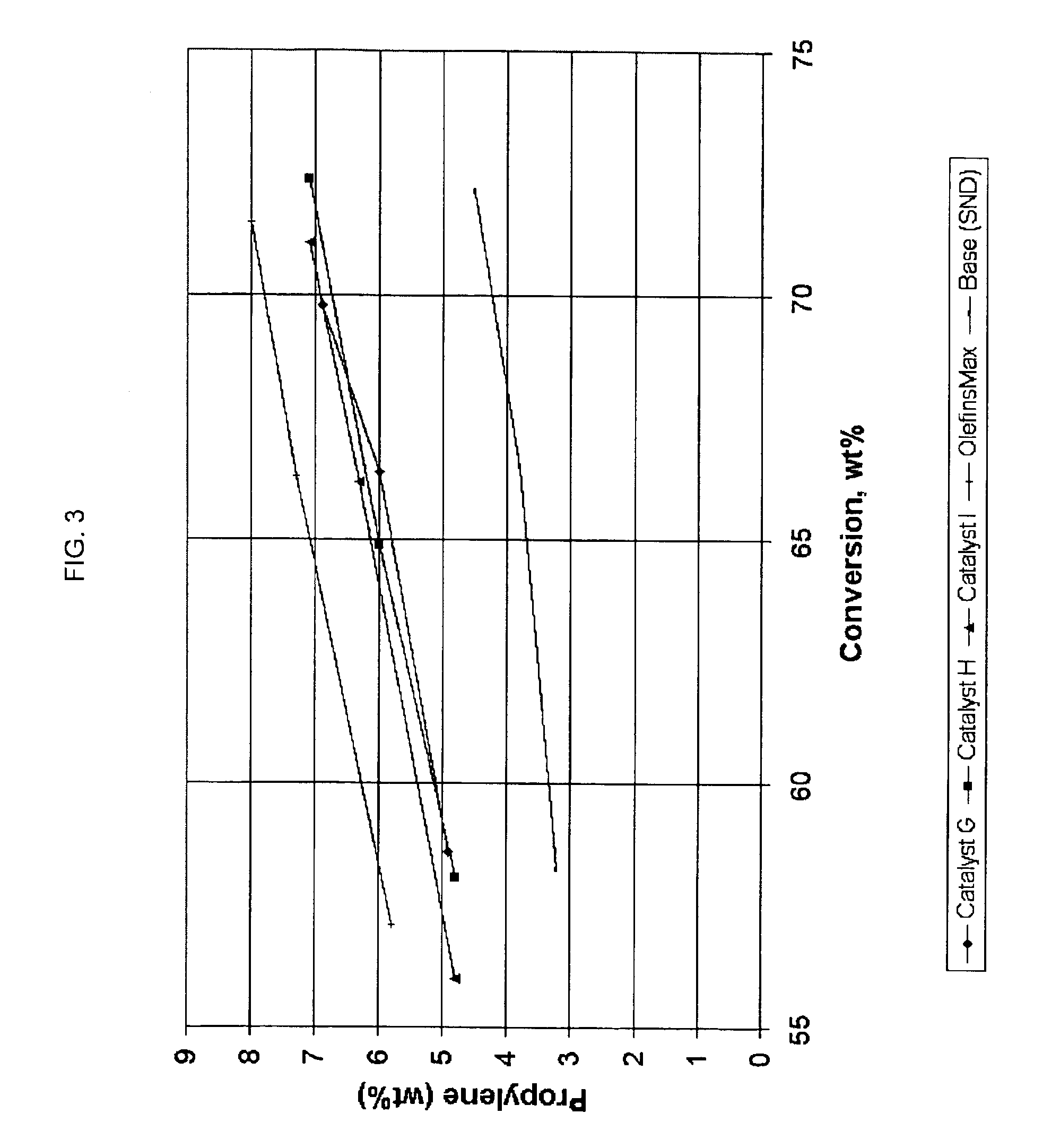High zeolite content and attrition resistant catalyst, methods for preparing the same and catalyzed processes therewith
a technology which is applied in the field of high zeolite content and attrition resistance catalyst, can solve the problems of increasing the cost of catalyst to the refiner, physical breaking down of catalyst into even smaller particles called “fines”, and large amount of 0-20 micron fines, and achieves high levels of stabilized zeolite, high active zeolite, and effective increasing the catalytic effect of reactions
- Summary
- Abstract
- Description
- Claims
- Application Information
AI Technical Summary
Benefits of technology
Problems solved by technology
Method used
Image
Examples
example 1
Preparation of 40% ZSM-5 / 6.5% Al2O3 Catalyst
[0072]An aqueous slurry containing 800 g of ZSM-5 (26:1 molar ratio of SiO2 to Al2O3) (dry basis), 830 g clay (dry basis), 130 g of Catapal B Al2O3 (dry basis) and 357 g of concentrated H3PO4 were blended and mixed at a 45% solids level. The slurry was then milled in a Drais mill and spray-dried in a Bowen spray-drier to prepare Sample A. Two additional preparations were made in the same manner, and were labeled Samples B and C, where the P2O5 and clay levels were varied as shown below:[0073]A. 40% ZSM-5 / 6.5% Catapal B / 11% P2O5 / 42.5% clay[0074]B. 40% ZSM-5 / 6.5% Catapal B / 12% P2O5 / 41.5% clay[0075]C. 40% ZSM-5 / 6.5% Catapal B / 13.5% P2O5 / 40% clay
The resulting materials were then calcined for 2 hours @ 1000° F. and analyzed by ICP, T-plot surface area, and DI attrition. The chemical and physical characterization data for Samples A-C is shown in Table 1 below. The catalysts have DI attrition numbers between 11 and 15.
[0076]
TABLE 1SampleABCFormul...
example 2
Microactivitv Testing of Example 1 Catalysts
[0077]The calcined catalysts in Example 1 were deactivated by steaming for 4 hours at 1500° F. / 100% steam in a fluidized bed steamer. The samples were then blended at a 2.5% additive level with a steam deactivated Super Nova™ D (Davison commercial cracking catalyst, 2.5% Re2O3 on catalyst). The admixture was used to crack Feed A (Properties in Table 2) in a Microactivity Test (MAT) as set forth in ASTM 3907.
[0078]
TABLE 2Feed AFeed BAPI Gravity @ 60° F.22.523.9Aniline Point, ° F.163198Sulfur, wt. %2.590.733Total Nitrogen, wt. %0.0860.1Basic Nitrogen, wt. %0.0340.042Conradson Carbon, wt. %0.250.33ASTM D-2887 SimdistIBP423464 5585592106156372064969330684730407207725075580660794844708348838088192790932977959761018FBP10271152
[0079]The base case catalysts tested with these samples included: 1) steam deactivated Super Nova D™ (SND) and 2) 96% steam deactivated SND blended with 4% steam deactivated conventional catalysts additive available as Olef...
example 3
Preparation of 40% ZSM-5 / 8% Al2O3 Catalysts
[0081]Catalysts were prepared in the same manner as Example 1 except with the following compositions:[0082]D. 40% ZSM-5 / 8% Catapal B / 11.5% P2O5 / 40.5% clay[0083]E. 40% ZSM-5 / 8% Catapal B / 13% P2O5 / 39% clay[0084]F. 40% ZSM-5 / 8% Catapal B / 14.5% P2O5 / 37.5% clay
[0085]The resulting samples were calcined for 2 hours @1000° F. and analyzed by ICP, T-plot surface area, and DI attrition. The chemical and physical characterization data is shown in Table 3. The catalysts have DI attrition numbers between 8 and 9.
[0086]
TABLE 3SampleDEFFormulationZSM-5404040P2O511.51314.5Al2O3888Clay40.53937.5Total100100100Physical Properties2 hours @ 1000° F.988DIAl2O327.5727.6426.81P2O512.413.6214.72SiO257.5756.2457.8P2O5 / Al2O30.320.350.38Total BET Surface126125118Area
PUM
| Property | Measurement | Unit |
|---|---|---|
| weight % | aaaaa | aaaaa |
| molar ratio | aaaaa | aaaaa |
| size | aaaaa | aaaaa |
Abstract
Description
Claims
Application Information
 Login to View More
Login to View More - R&D
- Intellectual Property
- Life Sciences
- Materials
- Tech Scout
- Unparalleled Data Quality
- Higher Quality Content
- 60% Fewer Hallucinations
Browse by: Latest US Patents, China's latest patents, Technical Efficacy Thesaurus, Application Domain, Technology Topic, Popular Technical Reports.
© 2025 PatSnap. All rights reserved.Legal|Privacy policy|Modern Slavery Act Transparency Statement|Sitemap|About US| Contact US: help@patsnap.com



